
Vol. XIV, No. 4, May 2014
- Editor's travelogue
- Do you really know who your competition is? - Part 2
- The different generations
- We're a Foodie Nation
- Early bird discount ends in 12 days
- A nascent trend - entertainment + restaurant + bar = third place social
- Births down, but don't despair
- The folly of not meeting the rising expectation for food sophistication and healthfulness
Births down, but don't despair
As we reported back in January, America's birth rate remains depressed four years after the end of the Great Recession based on final 2012 birth data. Preliminary data for 2013 indicates the birth rate is continuing its decline.
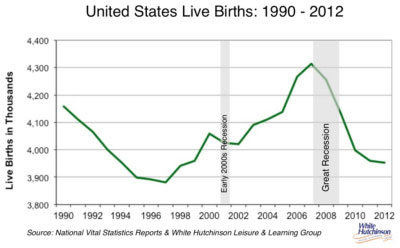
What this means is that what used to be the expectation that the number of children will always be on the increase is no longer be the case. In fact, the number of children becoming age six this year will be less than last year and there will be a continuing annual decrease in the number of age 6 children for at least the next five years. From its peak in 2007, the number of children born in 2012 was 9% less. This is not good news for the children's entertainment center industry. Fewer children means less potential customers.
But all is not gloom and doom. There are number compensating trends underway:
Education
More and more mothers with infants are college educated. This means an increasing number of mothers have higher incomes and greater disposable leisure dollars they can spend on their children's leisure activities (there is an almost direct relationship between educational attainment and income). In 2011, two-thirds (66%) of mothers with infant children had at least some college education.
From 2008 to 2011, the number of new mothers with less than a high school diploma declined 17%, and the number with only a high school diploma went down 15%. By contrast, the number of new mothers with some college education increased by 6%, and the number with a bachelor's degree or more increased by 1%.
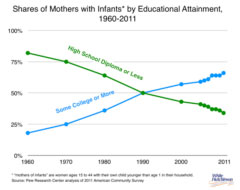
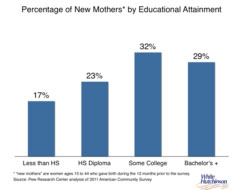
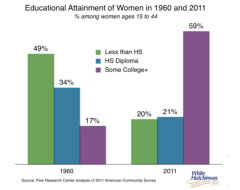
Although less educated women are a shrinking share of all new mothers, less educated women still have a higher average number of births throughout their lifetime than more educated women. By the end of their childbearing years, women without a high school diploma have on average 2.5 children, and women with a bachelor's degree have about 1.7. This gap has closed only slightly over the past 25 years.
Marriage
There are significant differences in the marital status of new mothers depending upon their educational attainment. While about six-in-ten (61% in 2011) women with less than a high school diploma are unmarried when they give birth, this share declines to only 9% among women with at least a bachelor's degree. Married couples with children generally have higher incomes than single parents.
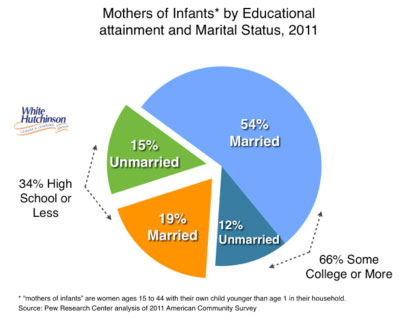
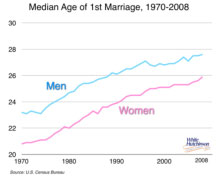
Age
The age when Americans marry for the first time has risen to its highest point since the 1950s. The age profile of new mothers varies by their educational attainment as well. While almost half (48%) of new mothers without a high school diploma are younger than 25, only 3% of new mothers with a bachelor's degree are younger than 25. Incomes generally increase with age, so again, there is a rising proportion of higher income mothers who will have disposable income to spend to take their children to location-based entertainment venues.
Stay-at-home
For the first time since 2004, the percentage of stay-at-home mothers is on the increase.
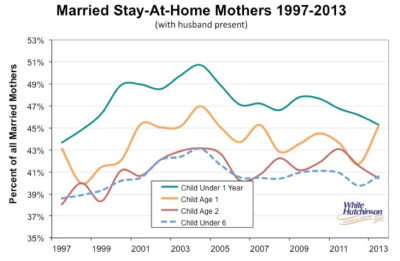
Stay-at-home mothers have the time to take their preschool children to entertainment venues during the daytime.
Due to this apparent increasing affluence of mothers with young children, we decided to take a look at entertainment spending by households with the oldest children younger than age 6 to see if perhaps the increasing affluence of many mothers is showing up in spending changes.
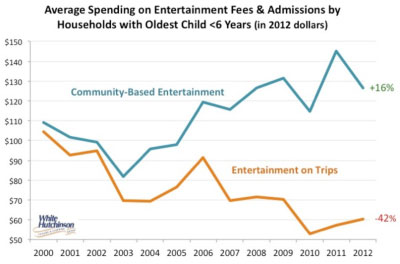
As the above graph illustrates, we found that community-based entertainment spending by households with the oldest child younger than age is on the increase (+16%). In fact, it didn't take a dip during the Great Recession like it did for many other types of households. However, to the contrary, entertainment spending on trips is down dramatically (-42%).
So there appears to be good news for community-based children's entertainment venues. Despite the declining birth rate, families with very young children are spending more for out-of-home entertainment, offsetting the decline in the number of births.
Vol. XIV, No. 4, May 2014
- Editor's travelogue
- Do you really know who your competition is? - Part 2
- The different generations
- We're a Foodie Nation
- Early bird discount ends in 12 days
- A nascent trend - entertainment + restaurant + bar = third place social
- Births down, but don't despair
- The folly of not meeting the rising expectation for food sophistication and healthfulness


